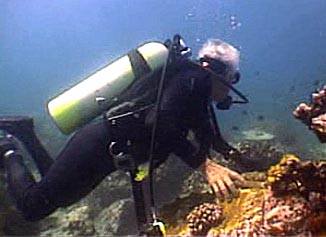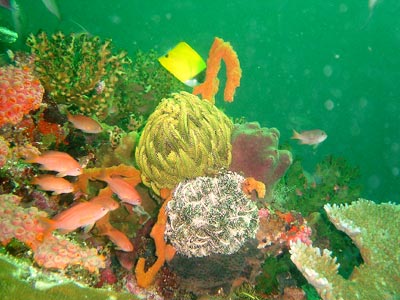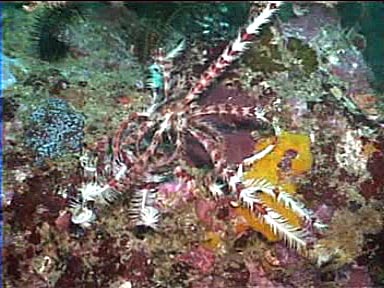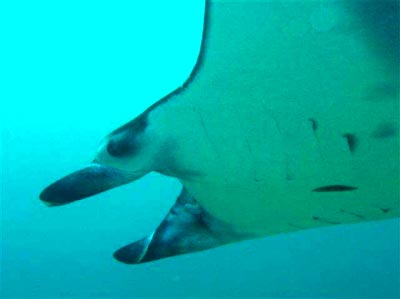

(D) Beneath the Dragon's kingdom
D.1 Introduction
Most sports divers dislike diving in locations with strong currents and widely fluctuating temperatures. But it is exactly in these inhospitable environments that one can seek sheer adventure, adrenaline-charged excitement and the thrill of discovery. And the Komodo National Park is one of the few dive destinations in the world that have all the elements to whet the appetite of the adventurous divers.
Indonesian islands form an archipelago that separates the warmer Pacific Ocean in the north from the colder Indian Ocean in the south. The group of islands, where Komodo National Park is located, acts like a dam that holds back the Pacific waters which are forcefully discharged through numerous narrow straits into the Indian ocean. The strong currents which run from north to south create a pressure void on the lee side of the islands and cold water from the south rises from the abyss causing a upwelling phenomenon and form spectacular surface whirlpools.
The fierce currents and the heavy upwelling result in nutrient rich water, which creates a biological paradise of incomparable splendor. As a result the reefs around Komodo are teeming with life, and divers are guaranteed some of the best diving of their lives.

D.2 The unpredictables
Though the diving is world-class, with dramatic walls, colossal pelagic and unusual pygmy critters, anyone diving in Komodo should be prepared to expect the unexpected.
Most dives we had were drift dives, moving with the prevailing current. However, very often the drift became fierce current as we moved across a channel or over a pinnacle. And on many occasions the strong current only lasted for a few minutes. We had to hold on to a solid rock when faced with such a situation and moved on when the current slacked to a comfortable drift.

However, near the lighthouse beside Gililawa Luat, an island located off the northern coast of Komodo Island, the drift dive turned unexpectedly into a flying current dive. All the divers together with the two dive masters had to hold on to solid boulders for dear life. In its worst moment, my regulator mouthpiece was nearly swept off and I had to free one of my hands to hold it. But in the process the strap of my underwater camera was dislodged from my wrist and all I could do was hopelessly seeing it disappeared into the abyss of the horrendous surging ocean. Luckily there was no other mishap and we surfaced safely when the current had abated somewhat. Also it was towards the end of our diving safari and I had already captured and saved enough beauties beneath the Dragon's realm in a CD to satiate my memories for a long time. Welcome to Komodo diving!
Beside the unpredictable current in the Komodo National Park, one must also be aware that calm water at the surface could develop into spinning whirlpools underneath. On the morning of our second day at sea, we were at GPS-Point, located off the northern coast of Gili Banta. The water surface was calm and though initially I could not descend easily with my new 5mm wet suit, I suddenly plunged effortlessly down a spectacular undersea wall. When I noticed my scuba bubbles going straight down, I then realized I was caught in a whirlpool. Luckily, I reached the sandy bottom and I was astounded to see my depth gauge showing a reading of 160ft! My buddy was already there and he nonchalantly showed me the 40m marking on his underwater-camera housing as if to inform me that the housing had passed the depth test! We were separated from the rest. Nevertheless we knew the danger we were in and ascended slowly along the slope where our dive master located us. It was a classic case of "still water runs deep"!

Water temperatures in Komodo National Park can fluctuate wildly. The sea surrounding the northern side of the Park is warm (27C) as it should be within 10 degrees latitude of the equator. But only about 15km away in Pantai Merah (Pink Beach) just off the mid-western coast of Komodo Island, I went down with my usual 1.5mm tropical suit. As soon as I touched the water I felt cold. The water was unusually chilly at the beginning but not uncomfortable. But the deeper I went the colder I felt (23C). Fearing that my legs might get cramps, I surfaced early though the corals were in profusion and in every color imaginable and there were many species of marine fishes, big and small.
D.3 Fab dive sites
Komodo diving is simply overwhelming with a staggering variety of underwater vertebrates and invertebrates thriving in bountiful habitats such as teeming reefs, offshore islets of various size and shape, sheltered bays, rocky coasts and precipitous drop-offs.
In our seven days live-aboard in MV Tarata, we had 18 day-dives and 6 night-dives. In spite of experiencing some anxious moments at a few locations, all of us had had the best diving of our lives.
Sites for night dives were normally near to where we did our late afternoon dives or near to where the boat was anchored. All night dives were superb; particularly in calm bays which seemed to come alive after dark with weird but wonderful creatures. We found crocodile fish, cuttlefish, mantis shrimps and many other species of marine critters. Our dive masters were excellent at locating tiny and unusual critters for us to see and many of us had a great time for macro-photography.
The more outstanding dive sites are described below:
1. Yellow Wall
The Yellow Wall is located near the entrance to the Horseshoe Bay at the southern tip of Komodo Island. We did this dive in the late afternoon when the sun lighted up the wall packed with a bountiful array of marine life especially its varied and colorful invertebrates. There are colorful sea urchins, bright red sea apples and myriad soft corals, whips and hard corals. There are many crevices in the wall where spiny lobsters, cleaner shrimps and decorator crabs could be seen.


The night dive at the Yellow Wall is even more enchanting and is probably the place on earth to see corals in full bloom.
2. Cannibal Rock
Cannibal rock is a small pinnacle located in the Horseshoe Bay, between Rinca and Nusa Kode. It is quite near to Yellow Wall and as such is famous for its varied and colorful invertebrate life. Rich soft corals abound as well as bright red sea apples and colorful sea urchins.


There are flamboyantly colored nudibranchs, pygmy seahorses, frogfishes and mantis shrimps. The fish life is good with schools of large pelagic. This site is quite extensive and we covered this area in two dives.
3. Manta Alley
This site is located in the bay at the southern tip of Komodo Island. Cooler water from the upwelling of water in the south provides a nutrient rich environment, which attracts many large pelagic including manta rays. Though my group of divers missed the manta, we encountered giant trevallies, beautiful corals and a high diversity of other invertebrate life.
All divers did a repeat dive at this site and this time my group of divers saw three big manta rays parading, with a cheeky one performing a somersault in front of us.

| previous page |